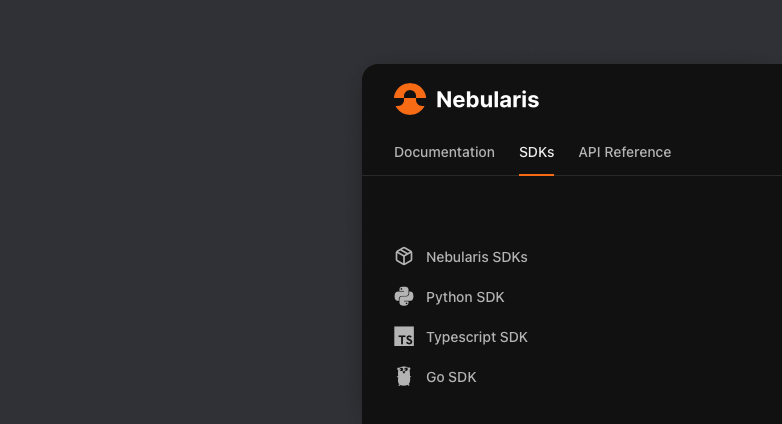Tabs and subtabs
Tabs and subtabs can be used to split your documentation into logical sections. Each section will have its own navigation and its content lives in its own subdirectory.

How tabs work
The basics of how tabs and subtabs work is as follows:
-
Tabs show up at the top of your project
-
Tabs may have subtabs, which will be shown above the main navigation
-
Each tab or subtab has its own navigation structure
-
If there is only one tab, no tabs are shown
-
If a tab has only one subtab (like in this demo), the subtabs section isn't shown for that tab
Defining tabs
Tabs are defined in your
docapella.yaml
file. Let's look at an example with both tabs and subtabs.
tabs:
- label: Home # This is the default tab
path: /
- label: SDK # This is another top-level tab
path: /sdk
subtabs: # Subtabs under the SDK tab
- path: /sdk
label: Nebularis SDKs
icon:
set: lucide
name: package
- path: /sdk/python
label: Python SDK
icon:
set: devicon
name: python
- path: /sdk/typescript
label: Typescript SDK
icon:
set: devicon
name: typescript
- label: API Reference # A final top level tab
path: /api/
Under the
tabs:
key, we define a list of 3 tabs, each with a label and path.
The second tab additionally has a
subtabs
field, which lists 3 subtabs.
Navigation
Every tab and subtab gets its own
navigation.yaml
file - this allows you to have multiple tabs with different navigation structures.
Create a
navigation.yaml
in the subdirectory of the tab or subtab for Docapella to use.
For example, if we have a tab with the path
/sdk
, we can create a
sdk/navigation.yaml
file for it.
Icons
You can add icons to your tabs and subtabs:
tab:
- path: /sdk
label: Nebularis SDKs
icon:
set: lucide
name: package
You can find the supported icon sets here .